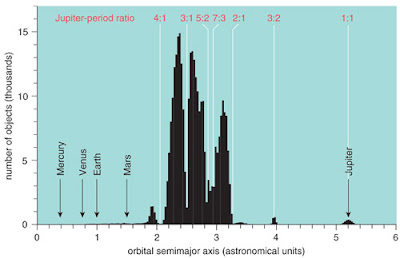Auto-organização na formação do sistema solar?

Resonant effects can be clearly seen in the radial distribution of the asteroids. Some orbital resonances are destabilizing, creating minima in the distribution, called "Kirkwood gaps" after Daniel Kirkwood, the astronomer who first recognized them. The main asteroid belt is bounded by the 4:1 and 2:1 orbital resonances with Jupiter. The stable 3:2 and 1:1 resonances account, respectively, for the Hilda family of asteroids and the Jupiter Trojans. The semimajor axis is one-half the long dimension of an object’s elliptical orbit. One astronomical unit is the Earth-Sun distance.
Graph by Barbara Aulicino. Distribution of asteroids courtesy of the Minor Planet Center.
Computer simulations suggest that the answer may be yes. But observations of extrasolar systems will provide the ultimate test
Steven Soter
Steven Soter
A few years ago, Rory Barnes and Thomas Quinn at the University of Washington used computer simulations to examine the stability of extrasolar systems having two or more planets. They found that almost all systems with planets that are close enough to affect one another gravitationally lie near the edge of instability. The simulations showed that small alterations in the orbits of the planets in those systems would lead to catastrophic disruptions.
This remarkable result might seem surprising. But the prevalence of such marginally stable systems makes sense, Barnes and Quinn concluded, if planets form within unstable systems that become more stable by ejecting massive bodies. The investigators remarked, "As unsettling as it may be, it seems that a large fraction of planetary systems, including our own, lie dangerously close to instability."
Barnes, now at the University of Arizona, and Sean N. Raymond, at the University of Colorado, went on to hypothesize that all planetary systems are packed as tightly as possible, as Laskar had suggested earlier. In some of the observed extrasolar systems, Barnes and Raymond identified apparently empty regions of stability around the central star. Those regions, they predict, contain planets small enough to have evaded detection.
For example, the star 55 Cancri has four known giant planets, three of them close in with short orbital periods and a more distant planet with a period of nearly 15 years. Between the inner three and the outermost planet lies a large area in which, Barnes and Raymond predict, one or more new planets will eventually be found. This region includes the "habitable zone," where a planet's surface temperature would allow liquid water to exist.
What we have here is a fascinating new hypothesis, which posits that our solar system and other mature planetary systems are filled nearly to capacity. The present configurations of such systems contain about as many planets as they can hold, spaced about as closely together as stability allows. Such is the expected outcome of the chaotic process that makes planets. A family of planetary embryos grows by feeding on a vast swarm of smaller objects in a debris disk until the system loses its brakes. Global instability then erupts, and the larger worlds consume or eject the more erratic ones until the system settles down into the mature state of marginal stability. The process is one of self-organization, increasing order within the system by exporting disorder to the external environment, in this case the Galaxy.
Comentários